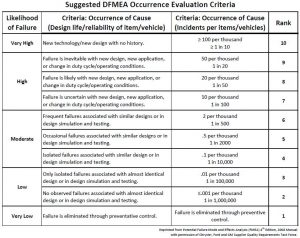Problems and Solutions
Assessing the occurrence ranking is one of the more challenging aspects of FMEAs. This article presents problems that relate to occurrence risk assessment, based on a fictitious case study, and highlights a common mistake.
If you haven’t yet read the article “Understanding FMEA Occurrence Risk – Part 1” this may be a good time to read about the underlying fundamentals of assessing occurrence risk in FMEAs.
Beginner’s Problem
You are doing a Design FMEA. Using the occurrence scale shown below, select an appropriate occurrence ranking for a failure mode / cause that has a 1 in 500 chance of occurring, within the design life of the product.
Beginner’s Solution
An occurrence likelihood of 1 in 500, using the above scale, would correspond to an occurrence ranking of 6.
Intermediate Problem
You have been asked to perform a Design FMEA on the hand brake subsystem of a new version of the All-Terrain bicycle. One failure mode is “Insufficient friction delivered between brake pad assembly and wheel rim to safely stop bicycle in required distance.” The effect is “Bicycle wheel does not slow down when the brake lever is pulled potentially resulting in accident” and one potential cause is “Cable Binds due to inadequate lubrication.”
You are trying to determine the occurrence ranking. The field representative on your FMEA team says they have actual data that shows there has been one accident that resulted from this failure mode, out of 10,000 users. Since this amounts to 0.0002 likelihood of accident, the team determined an occurrence ranking of 2 would be appropriate, based on the scale they were using.
Was this the correct method to determine occurrence ranking? Why?
Intermediate Solution
Unfortunately, this is not the correct method for determining occurrence ranking. Occurrence is a ranking number associated with the likelihood that the failure mode and its associated cause will be present in the item being analyzed. The team has identified the occurrence of the effect, not the occurrence of the failure mode and its associated cause. The team needs to assess the likelihood of the cause, “Cable Binds due to inadequate lubrication”, during the life of the all-terrain bicycle.
Advanced problem
Using the Intermediate Problem (above) of Design FMEA on the hand brake subsystem, the team needs to correctly assess the likelihood of the cause, “Cable Binds due to inadequate lubrication” during the life of the all-terrain bicycle. What are three sources of information that the team can use to help determine the occurrence ranking for this cause?
Advanced Solution
The following is a partial list of potential sources of information that the FMEA team can use:
- Warranty data from the previous version of the all-terrain bicycle.
- Tech-support phone records for the previous version of the all-terrain bicycle.
- Surveys of actual all-terrain bicycle customers regarding failures they have experienced during the life of their product.
- Interview with brake cable design engineer, asking subjective assessment of likelihood of this particular cause, given the current design of the brake cable and lubrication.
- Bicycle durability testing for the previous version of the all-terrain bicycle.
- “Change point” analysis of the specific changes (material, geometry, customer usage, environment, etc.) that are planned for the hand brake subsystem, specifically focusing on brake cable and lubrication.
- Review of the Prevention-type controls for the cause that is being analyzed. Recall that prevention-type controls are input to the occurrence ranking.
Correctly assessing the occurrence ranking is one of the more challenging aspects of FMEA. Teams can use a variety of sources of information to make this assessment.
Next Article
Ponder this question: Let’s say you are an OEM and assemble parts made by various suppliers. When performing your Process FMEA, do you consider special characteristics for components in your Process FMEA? This question is discussed and answered in the next FMEA Q and A article.

 Ask a question or send along a comment.
Please login to view and use the contact form.
Ask a question or send along a comment.
Please login to view and use the contact form.
What is an available reference table (criteria table) of Occurrence for an infrastructure construction (e.g. bridge) work? Does any research mentioned that?
Hi Wan-Chuan,
Thank you for your question about Occurrence table for infrastructure construction.
I know of no research that provides an Occurrence table for infrastructure construction. The published Occurrence tables are in FMEA standards, and they are mostly generic. However, FMEA standards allow modification of rating tables by individual users. I suggest that you work with your company to modify the published tables to make sense for your application, specifically the criteria column.
Let me know if this answers your question or if you need further assistance.
Thanks.
Carl